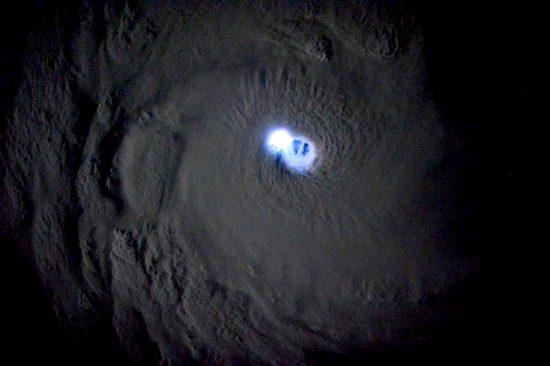
Lightning in the eye of Cyclone Bansi. Credit: astronaut Samantha Cristoforetti, International Space Station. Click to enlarge.
Jul 20, 2018
Electrons and positrons are formed in lightning bolts.
Lightning is a plasma that creates powerful electromagnetic pulses across a wide range of frequencies. Thunderheads may be several thousand cubic kilometers in extent, yet all of that stored electrical energy travels down a discharge channel no wider than a man’s waist. The z-pinch effect inside a lightning bolt’s vortex causes rapid ionization, as well as particle acceleration fast enough to generate gamma rays.
According to a recent press release, “…scientists observed something new: a downward beam of positrons, the antimatter counterpart of electrons…”
Positrons are electrons with an opposite charge. They are created when gamma-rays influence atomic nuclei, forming an electron and a positron, which are accelerated in opposite directions by the storm’s electric field. As a previous Picture of the Day reported, gamma-rays are often created in hurricanes and thunderstorms. Since gamma-rays are the precursor for the production of electron/positron pairs, both phenomena must be initiated in the same electrical events.
As mentioned many times in these pages, electric discharges in plasma form magnetic sheaths along the current axes called “double layers”. Double layers form when positive charges build up in one region of a plasma cloud and negative charges build up nearby. A powerful electric field appears between the two regions, which accelerates charged particles. The electric charges spiral in the magnetic fields, emitting X-rays, extreme ultraviolet, and gamma-rays.
The electric field beneath a thunderstorm can exceed 10,000 volts per meter, storing energy from the surrounding environment like a capacitor. A “wind” of charged particles blows toward the storm. In other words, an electric current flows into the cloud base whose powerful updrafts can rise into the stratosphere.
As physicist and Electric Universe advocate Wal Thornhill wrote:
“In the Electric Universe model, there is no antimatter forming antiparticles. An electron and a positron are composed of the same charged sub-particles in different conformations. They come together to form a stable neutrino, emitting most of their orbital energies in the process. They do not annihilate each other. In that sense a neutrino embodies both the electron and the positron. It can have no antiparticle. The bookmakers would be wise not to bet on the Standard Model of particle physics.”
Stephen Smith
Hat tip to Christopher Phillips












